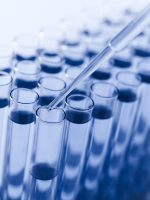Your DNA
Quantitative Analysis of Unstable Isotope Decay in DNA
DNA consists of base pairs of Adenine, Thymine, Guanine, and Cytosine molecules connected with Phosphate and Deoxyribose
molecules. Adenine connects with a Thymine to form a base pair, while Guanine connects with Cytosine to form another base pair.
Adenine, Thymine, Guanine, and Cytosine molecules consist of Carbon, Nitrogen, Oxygen, and Hydrogen. The Phosphate molecule that connects base pairs contains a Phosphorus atom with four Oxygen
atoms. The Deoxyribose molecule which also connects the base pairs contains four Carbon and one Oxygen atoms.
Carbon and Hydrogen have one naturally occurring unstable isotope each. Phosphorus has two naturally occurring unstable isotopes. These unstable isotopes are continuously produced in the
Earth’s atmosphere by high-energy cosmic and solar radiation. Oxygen and Nitrogen do not have naturally occurring unstable isotopes with half lives long enough to become constituents of
DNA.
Carbon Composition
The Adenine, Thymine, Guanine, and Cytosine molecules respectively contain 5, 5, 5, and 4 carbon atoms each. Therefore, each A-T base pair contains 10 carbon atoms, while each G-C base pair cotnains 9. And, there are 5 carbon atoms in each Deoxyribose molecule. Since a pair of Deoxyribose molecules is needed with each base pair, on the outside of the helix, a total of 20 carbon atoms is needed for each A-T base pair, while 19 are needed for each G-C base pair. This yields an average of 19.5 carbon atoms per base pair.
The Genome Reference Consortium (GRC) Human Genote Assembly build 38 has identified 5,963,271,354 base pairs per Male human and 6,062,084,834 per Female. This difference is naturally due to the 23rd chromosome. This provies an average of 6,012,678,094 base pairs per human DNA, each with a total of 117,247,222,833 carbon atoms. Since the natural abundance of 14C is near 1 part per trillion, and because there are nearly 3 trillion nucleated cells per human, the total 14C present in human DNA is near 352 billion.
Since 14C has a half life of 5.73x10^3 years, there are 30.7 million 14C decays per year in human DNA, or 84.0 thousand per day, or 0.973 decays per second. The molecular change in the DNA resulting from the 14C -> 14N decay can result in potential bond ruptures, DNA strand breakage, and nitrogen substitution in canonical bases which could affect the respective encoding, decoding, or subsequent transcription of the related genes. Also, the Beta particle decay releases 0.156476 MeV per decay, or 1.3x10^4 MeV per day, in our DNA.
Hydrogen Composition
The Adenine, Thymine, Guanine, and Cytosine molecules respectively contain 2, 5, 4, and 3 hydrogen atoms each. Meanwhile, there are 10 hydrogen atoms in each Deoxyribose and none in the phosphate molecules that connect the base pairs. Coincidentally, A-T and G-C base pairs both have 7 hydrogen atoms each, so with the deoxyribose groups, there is a total of 27 hydrogen atoms per base pair.
Using the average number of base pairs in male and female human DNA from the Human Genote Assembly build 38, and 27
hydrogen atoms per base pair, there are 162,342,308,538 hydrogen atoms per human DNA in each cell. With 3 trillion nucleated cells, and a natural abundance of 3H near 1x10-16, the average human
has about 48.7 million 3H atoms in the DNA of their body.
Since 3H has a half life of 12.32 years, there are 1.98 million 3H decays per year in human DNA, or 5,412 per day, or 3.8 decays per minute. The molecular change in the DNA resulting from the 3H
-> 3He decay could also result in bond ruptures and DNA strand breakage effecting the respective encoding,
decoding, or subsequent transcription of respective genes. Also, the Beta particle decay releases 0.01859 MeV per decay, or 100.6 MeV per day, in our DNA.
Spontaneous Genetic Mutations
The quantitative analysis of Carbon-14 and Hydrogen-3 decay in human DNA suggests that damaging and denaturing DNA is
currently a continuous part of nature. Our bodies are in a constant state of repair, or shut-down of cells that have malfunctioned. In fact, as long as humans consume and consist of
unstable isotopes, it's only a matter of time before a mutation happens that our cells are not capable of repairing or stopping. Cancer occurs in each type of human body tissue as a result of
these spontaneous genetic mutations that occur "naturally" due to our environment which includes "natural" radioactive unstable isotopes.
Linus Pauling, the Nobel laureate, once believed that Vitamin C could cure cancer. He thought that if enough anti-oxidants were applied to a biological system, that all of the sources of error
could be stopped and repaired. But, the since the source of error is nuclear in nature, and completely unpredictable in timing and manifestation (in terms of genetic location), attempting to
repair the damage with chemical means after the fact, was, is, and continues to be for all of us presently, a losing battle.

